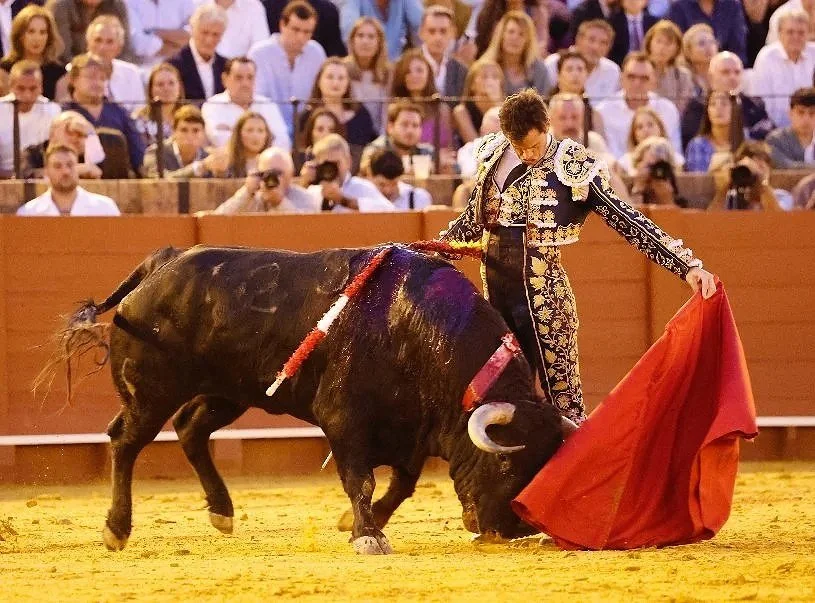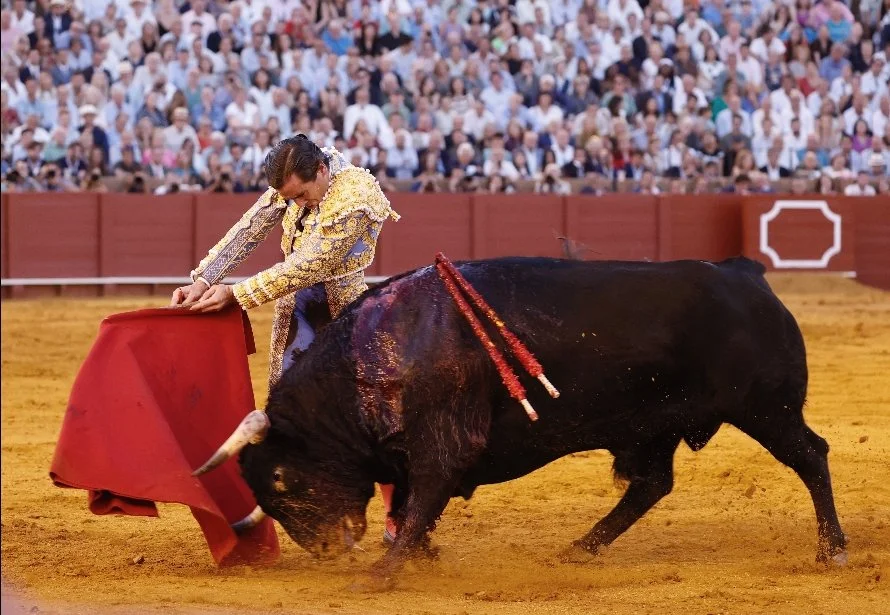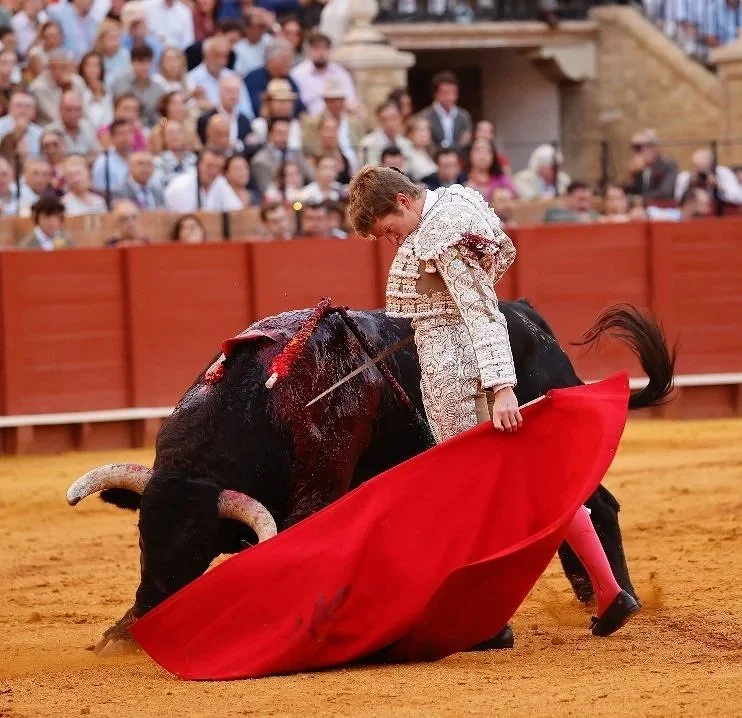The best of Sevilla’s San Miguel faenas
Daniel Luque and ‘Olvidado’ (Image from Empresa Pagés)
One should always aim to take into account the qualities of a bull when judging a matador’s performance. With this in mind, how do the top performances of this year’s Feria de San Miguel in Sevilla compare? One could argue that Morante de la Puebla’s brief faena to his first Núñez del Cuvillo bull - a brilliant exposé and rapid despatch of a bull not fit for a triumph - should be considered amongst these, but this article concentrates on those lidias that caused a majority of spectators to petition for an ear to be awarded at their end.
Juan Ortega with ‘Bocinero’ (Victoriano del Río)
(Image from Empresa Pagés)
Juan Ortega, at this stage of his career anyway, needs a decent bull in order to shine, and, in the large-horned (for Sevilla) ‘Bocinero’, he drew an excellent accomplice. It left the capote twice in the initial lances, but otherwise returned to the lure well and humillando and followed through a fine templado series of three verónicas and a media. The bull’s aggression seemed to increase in its second charge to the picador, and David de Miranda, knowing a good thing when he sees it, stepped in for a superb quite of cordobinas and a larga. ‘Bocinero’ continued to exhibit a strong charge en banderillas and then ran across to Ortega before the matador could complete a brindis, Juan meeting it with his characteristic half-kneeling muletazos and doblones before going to the centre of the arena for a dedication to the public. Impressive derechazos followed, the bull continuing to humillar and turning to eagerly to come back to the muleta. Ortega’s second series of derechazos, begun with a capeina, saw better linking, with the matador back down on one knee at the tanda’s end. A molinete heralded a series of naturales, patchy at first, but the second half very good indeed, and a chest pass. After this, Ortega engaged in further circling of a bull that offered collaboration without challenge, returning to the right hand for more linked derechazos and a molinete. Then, with the estoque taken, we had closing ayudados por alto, and a last natural and chest pass before the estocada was sunk into ‘Bocinero’, hasta la bola but somewhat low, which probably kept the award to a single ear.
Borja Jiménez with ‘Arrocero’ (Garcigrande)
(Image from Empresa Pagés)
Borja Jiménez’s first garcigrande did not have the level of qualities of ‘Bocinero’, but was pretty good nevertheless. It showed a tendency to escarbar early on, but also a fast charge and a head lowered in the lure. Jiménez gave it several capotazos, but just two well-formed verónicas (having to adjust in one to avoid his oncoming opponent) and a media. ‘Arrocero’ made a great charge into the picador’s horse, almost knocking it over, and was just as impressive in its second vara. There was a light third puyazo before Alejandro Talavante took the opportunity of a fine quite of chicuelinas and larga. ‘Arrocero’ continued to charge strongly in the tercio de banderillas and Jiménez dedicated to the spectators before enticing it to the centre of the arena for two pases cambiados por la espalda, four lovely naturales and a trincherilla, all given on one spot. Derechazos and naturales followed, ‘Arrocero’ demonstrating its speed and keeness, and Borja unworried about citing for it from a distance. Then the quality of the faena lessened as the bull began hooking vertically in linked derechazos and Borja could only manage scrappy naturales, losing ‘Arrocero’ half way. A further tanda of naturales, ended with trincherillas and a pase de pecho, brought improvement and the estocada was delivered well and proved immediately effective. The bulk of commentators identified a majority petition, but the president wasn’t convinced, Borja taking a vuelta instead.
David de Miranda with ‘Maleado’ (Toros de Cortés)
(Image from Empresa Pagés)
David de Miranda, largely ignored by the empresas this year despite his Puerta del Príncipe triumph here in May and recognition as the triunfador of Sevilla’s main feria, came into San Miguel as a substitute for the announced, but injured, Manzanares, and very much with a point to prove. His first bull, carrying the main ganadería Victoriano del Río’s sister hierro, proved none too easy, but David’s determination and bravery won the day. ‘Maleado’ returned to the capote time and again in the opening verónicas and went into the horse well for its opening vara, but, after a misjudged remate from de Miranda that nearly resulted in a cogida, appeared disinterested in its second puyazo. Pablo Aguado received a merited ovation for his quite of chicuelinas and a media, causing de Miranda to respond and elicit another ovation with some close saltilleras, a revolera and larga. After banderillas, there was a brindis to the public, but ‘Maleado’ was trotting by now, rather than charging strongly. De Miranda began the faena with pases ayudados from on one knee, then stood for some close derechazos (the first two enganchados) and a pase de pecho. Moving the muleta to the left hand, David began giving naturales, but was almost caught after the second when ‘Maleado’ moved towards him, the gap between the proferred lure (lost in the encounter) and the matador possibly too big. De Miranda recovered to produce a series of four naturales and a chest pass, each given with the feet together and begun with the matador standing nearer his bull. In the next series of derechazos and chest pass, ‘Maleado’ was more hesitant about coming forward and kept its head at stomach height. De Miranda was determined to prevail, however, and, despite the bull’s by now short charge, brought off a tanda of feet-together naturales and a chest pass followed by some very good derechazos and a series of very close and finely-judged luquesinas that brought several in the crowd to their feet. A final sequence of close bernadinas had the crowd excited once more, and the estocada, the sword in to the hilt but low, led to an ear for a torero who must surely now claim a spot in the major ferias in 2026. (Shortly after this San Miguel performance, it was announced that de Miranda and his manager for the last two seasons, José Luis Pereda, were parting company, doubtless with an eye on the matador encountering more propitious management arrangements for next year’s temporada.)
Daniel Luque with ‘Olvidado’ (Garcigrande)
(Image from Empresa Pagés)
The garcigrande ‘Olvidado’ was one of the feria bulls least likely to be involved in a triumphal faena, but the concentrated effort and technical mastery of Daniel Luque, saw the animal dragged out en arrastre minus one of its ears. ‘Olvidado’ showed its poor qualities from the start of its lidia, hesitating before charging to the capote, hooking when in the cape and departing on its own accord for other areas of the plaza. Eventually, Daniel managed to capture and keep it in the capote until releasing it with a sculptured media verónica. However, there was more wandering from the bull prior to las varas and a lot of talking between cuadrilla and matador, with the latter nearly caught as he took ‘Olvidado’ to the picador. The bull did push in the peto during its second vara, but remained unpromising here and en banderillas, Luque deciding against any brindis. With the muleta, Daniel gave some distant passes to take ‘Olvidado’ to los medios, the bull’s focus on the lure seemingly increasing, only for Daniel to break away from giving derechazos when ‘Olvidado’ cut in on the matador. After a couple more unpromising derechazos, Luque moved the cloth to his left hand, where he discovered the bull was better, enabling him to bring off naturales con temple. Thereafter, the faena was built on naturales, Sevilla’s band striking up after a second series comprised five composed naturales, an exquisite cambio de mano and a pase de pecho. Luque repeated the combination, settling for three naturales this time, then managed four more excellent and sustained series with the left hand, the bull’s charge shortening all the time, the matador introducing variety through citing with the pico being switched from side to side in front of the bull’s muzzle, passing ‘Olvidado’ with his feet together and closing one tanda with a chest pass that curved the bull right around his body. After the fourth series (five and a half naturales and a trincherilla to finish), it was clear a tired bull had no more to offer. Daniel collected the estoque, sank two-thirds of it into the killing spot and stood close to ‘Olvidado’ as it embarked on a dramatic attempt to stay alive. An ear was awarded to the matador for what was the best faena of the feria.




